|

Tribal Flag of the Southern Ute Tribe
Total population: 10,000
Regions with significant populations: United States (Utah, Colorado, New Mexico)
Languages: English, Ute
Religion: Christianity, Native American Church, other
The Ute are an American Indian people now living primarily in Utah and Colorado. There are three Ute tribal reservations: Uintah-Ouray in northeastern Utah (3,500 members); Southern Ute in Colorado (1,500 members); and Ute Mountain which primarily lies in Colorado, but extends to Utah and New Mexico (2,000 members). The name of the state of Utah was derived from the name Ute. The word Ute means "land of the sun" in their language.
Language
The native Ute language belongs to the Numic division of the Uto-Aztecan family of languages and is a dialect of Southern Numic. However, most current Utes speak only English. Peoples speaking Shoshonean dialects of the Numic family include the Bannocks, Comanches, Chemehuevi, Goshutes, Paiutes and Shoshones. They share an individual language with Shoshonean.
History
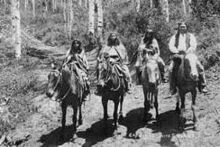
Ute indians year 1878
Prior to the arrival of Mexican settlers, the Utes occupied significant portions of what are today eastern Utah, western Colorado, including the San Luis Valley, and parts of New Mexico and Wyoming. The Utes were never a unified group within historic times; instead, they consisted of numerous nomadic bands that maintained close associations with other neighboring groups. The 17 largest known groups were the Capote, Cumumba, Kapote, Moache, Moanumts, Pah Vant, Parianuche, San Pitch, Sheberetch, Taviwach, Timanogots, Tumpanawach, Uinta, Uncompahgre, White River, Weeminuche, and Yamperika. Unlike many other tribal groups in this region, they have no tradition or evidence of historic migration to the areas now known as Colorado and Utah - ancestors of the Ute appear to have occupied this area for at least a thousand years. The last time the ute ever migrated was in the year 1885.
Contact
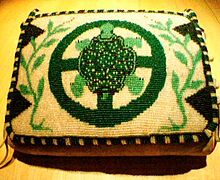
An early 1900s Uncompahgre Ute Beaded Horse Bag
This bag is made from brain-tanned mule-deer hide, 30,000+ glass trade beads, and tobacco balls stitched into the rim and sides of the bag for protection. These bags were used to hold sacred religious totems, pipes, and carvings, sometimes an effigy of a medicine horse or medicine buffalo, or some other totem of power. The bags were not opened to view the contents except during ceremonies or in private. The objects were associated and used in private prayer and family rituals.
Contact with Spanish explorers
The Utes' first contact with Europeans was with early Spanish explorers in the 1630s. They adopted the horse, obtaining mounts through trading with the Spanish colonists in New Mexico or theft from those settlements. As a result of the new mobility, Ute culture changed dramatically in ways that paralleled the Plains Indian cultures of the Great Plains. The social upheaval resulted in various degrees of consolidation, political realignment and tension between the various Ute groups. The Utes were for the most part enemies of the Spanish and the conquered Pueblo towns. They engaged in a long series of wars, in some cases three-sided, with the Navajo, various other Apache tribes, and the Comanche, especially in the plains of eastern Colorado and northeastern New Mexico.
Contact with Other European Settlers
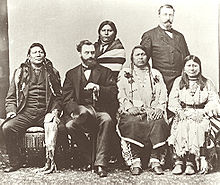
Delegation of Ute Indians in Washington, D.C. in 1880
Background: Woretsiz and general Charles Adams (Colorado) are standing. Front from left to right: Chief Ignatio of the Southern Utes; Carl Schurz US Secretary of the Interior; Chief Ouray and his wife ChipetaThe Ute experience with European-American settlers is similar to that of many other Native American groups: competition, confrontation and eventual coerced relocation to reservations. Of particular interest are the Walker War (1853-54) and Black Hawk War (1865-72) in Utah.
Over the years, friction between recently arrived white settlers and goldseekers in Utah and Colorado and local Ute groups resulted in several skirmishes and incidents. In the same period, the Ute sometimes allied with the United States in its wars with the Navajo, for example in 1863, and with the Apache.
A series of treaties established a small reservation in 1864 in northeast Utah, and a reservation in 1868, which included the western third of modern Colorado. The latter included land claimed by other tribes. Their lands were whittled away until only the modern reservations were left: a large cession of land in 1873 transferred the gold-rich San Juan area, which was followed in 1879 by the loss of most of the remaining land after the "Meeker Massacre". 
Eventually, the various bands of Utes were consolidated onto three reservations. Several of these bands maintain separate identities as part of the Ute tribal organizations. Although initially large and located in areas that white settlers deemed undesirable (occupying parts of Utah and most of western Colorado), the territory of the reservations was repeatedly reduced by various government actions, and encroachment by white settlers and mining interests. In the 20th century, several U.S. federal court decisions restored portions of the original reservation land to the Ute Tribes' jurisdiction and awarded monetary compensations for losses.
Northern Ute Culture
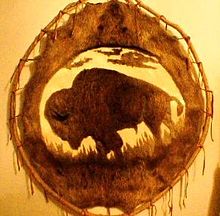
An Uncompaghre Ute Shaved Beaver Hide Painting
The Northern Ute would trap beavers, shave images into the animals' stretched and cured hides, and use them to decorate their personal and ceremonial dwellings. The Northern Utes, consisting of the Whiteriver, Uintah, and Uncompahgre bands, are exceptional artists and produced extraordinary examples of religious and ceremonial beadwork, unusual art forms, and designed and decorated weapons of war in their traditional culture. The Ute obtained glass beads and other trade items from early trading contact with Europeans and rapidly incorporated their use into religious, ceremonial, and spartan objects.
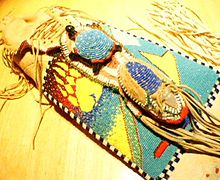
A Northern Ute Beaded Pipebag
This pipebag is made from brain-tanned mule-deer hide, more than glass trade beads, and eagle bone. This pipebag incorporates the sacred symbols of the Ute, the blue fire, the yellow fire, the green of the earth and the hail of the thunder beings, motifs of the turtle (earth) and moccasin (home), and the symbol of the red fire and the bear, sacred animal of the Ute.Like their southern neighbors, the Diné (Navajo), today a large percentage of Northern Ute are members of the Native American Church and participate in sacred ceremonies that use peyote. Traditional Ute healers use peyote to treat infections, and a variety of other plants, including Elk Root, Bear Root (Ligusticum porteri), and tobacco sage. The Ute have integrated peyote religion into their culture; its artistic and expressive influences pervade their art and rich cultural and ceremonial objects. There is evidence the Ute have used peyote obtained through trade and other potent ceremonial plants used as entheogens since ancient times, such as the dried leaves of Larb (a species of Manzanita), tobacco sage collected from the Escalante area (a mild hallucinogen when smoked), and the potent and narcotic White Uinta water lily. Tobacco Sage was also brewed into a tea with Elk Root and the root of the Yellow Uinta water lily, and used to treat tumors and cancer. (While the root of the Yellow Uinta water lily is toxic in large amounts, small amounts can be used to strengthen the heart muscle in people with heart ailments.)
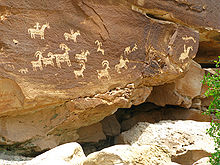
Ute Petroglyphs at Arches National Park 
Ute religious beliefs borrowed much from the Plains Indians after the arrival of the horse. The Northern and Uncompahgre Ute were the only group of Indians known to create ceremonial pipes out of salmon alabaster, as well as a rare black pipestone found only in the creeks that border the southeastern slopes of the Uinta Mountains in Utah and Colorado. Although Ute pipe styles are unique, they resemble more closely the styles of their eastern neighbors from the Great Plains. The black pipestone is also used to make lethal war clubs that warriors used to great effect from the back of a horse. The Ute have a religious aversion to handling thunderwood (wood from a tree struck by lightning) and believe that the thunder beings would strike down any Ute Indian that touched or handled such wood. This is also a Diné (Navajo) belief. There is extensive evidence that contact between the two groups existed since ancient times.
Each spring the Utes (Northern and Southern) hold their traditional Bear Dances. Origin of the Bear Dance can be traced back several centuries. Each year, a mid-summer fasting ceremony known as the Sun Dance is held; this ceremony has important spiritual significance to the Ute.
...The Uncompahgre Ute Indians from central Colorado are one of the first documented groups of people in the world known to utilize the effect of mechanoluminescence through the use of quartz crystals to generate light, likely hundreds of years before the modern world recognized the phenomenon. The Ute constructed special ceremonial rattles made from buffalo rawhide which they filled with clear quartz crystals collected from the mountains of Colorado and Utah. When the rattles were shaken at night during ceremonies, the friction and mechanical stress of the quartz crystals impacting together produced flashes of light which partly shone through the translucent buffalo hide. These rattles were believed to call spirits into Ute Ceremonies, and were considered extremely powerful religious objects.
Modern History
...Present-day Utes occupy a small fraction of their former territories.
Ute Indian Tribe of the Uintah and Ouray Reservation
The largest tribes are the Northern Ute, which live on the Uintah and Ouray Reservation in northeastern Utah. It is the largest of several groups of Ute and Shoshone Indians that were relocated to the Northern Ute Indian Reservation during the late 19th and early 20th century, including the Northern Shoshone, Uintah, Uncompahgre, White River, and Southern Ute.
Some believe that the Northern Ute disfranchised the other Ute groups when they reorganized during the mid-20th century and gained control of the Uintah and Ouray Indian Reservation as a result. The people of the U & O reservation are well aware of their own ancestries. Lawsuits and litigation have been commonplace between mixed-blood Utes and the Northern Ute Tribe for rights to tribal enrollment and privileges. The Northern Ute Tribe has a 3/4 blood quantum requirement for tribal membership, higher than most tribes. Mixed-blood Utes with a lower percentage of Ute ancestry have accused the tribe of disfranchisement in terms of rights to tribal lands and equal legal treatment.
Some affiliates, descendants of certain Northern Ute families who in earlier years decided against enrollment and federal recognition of their native ancestry, live on the reservation land holdings owned by particular families since the Federal government forced relocation in 1881. The Affiliate Utes have recently applied for federal recognition and are involved in litigation with the United States and the Northern Ute tribe. The Affiliates should not be confused with other mixed-blood Utes, which families did not choose to be unrecognized. Some Utes of partial descent are enrolled as Northern Utes, but are also active members of the Affiliates.
Northern Utes can be found all over the world. They have learned to adapt to various societies. A northern Ute is also called Nuchu. Various bands have more complex names and each name has a meaning. Over the years the Northern Ute language has changed extensively with the combinations of different dialects and English language influences.
The Northern Ute Tribe began repurchasing former tribal lands following the Indian Reorganization Act of 1934. They gained return of the 726,000-acre (2,940 km2) Hill Creek Extension by the federal government in 1948. More recent court decisions of the 1980s have granted the Northern Utes "legal jurisdiction" over three million acres (12,000 km²) of alienated reservation lands. Discoveries of oil and gas on Ute land in Utah hold the promise of increased living standards for tribal members.
Ute pipe styles are similar to those of the Plains Indians, with notable differences. Ute pipes are thicker and use shorter pipestems than the Plains style, and more closely resemble the pipe styles of their Northern neighbors, the Shoshone. In 1965, the Northern Tribe agreed to allow the US Bureau of Reclamation to divert a portion of its water from the Uinta Basin (part of the Colorado River Basin) to the Great Basin. The diversion would provide water supply for the Bonneville Unit of the Central Utah Project. In exchange, the Bureau of Reclamation agreed to plan and construct the Unitah, Upalco, and Ute Indian Units of the Central Utah Project to provide storage of the tribe's water. By 1992, the Bureau of Reclamation had made little or no progress on construction of these facilities. To compensate the Tribe for the Bureau of Reclamation's failure to meet its 1965 construction obligations, Title V of the Central Utah Project Completion Act contained the Ute Indian Rights Settlement. Under the settlement, the Northern Tribe received $49.0 million for agricultural development, $28.5 million for recreation and fish and wildlife enhancement, and $195 million for economic development.
Southern Ute Tribe
The Southern Ute Indian Reservation is located in southwestern Colorado, with its capital at Ignacio. The area around the Southern Ute Indian reservation are the hills of Bayfield and Ignacio, Colorado.
The Southern Ute are the wealthiest of the tribes and claim financial assets approaching $2 billion. Gambling, tourism, oil and gas, and real estate leases, plus various off-reservation financial and business investments, have contributed to their success. The tribe owns the Red Cedar Gathering Company, which owns and operates natural gas pipelines in and near the reservation. The tribe also owns the Red Willow Production Company, which began as a natural gas production company on the reservation. It has expanded to explore for and produce oil and natural gas in Colorado, New Mexico, and Texas. Red Willow has offices in Ignacio, Colorado and Houston, Texas. The Sky Ute Casino and its associated entertainment and tourist facilities, together with tribally operated Lake Capote, draw tourists. It hosts the Four Corners Motorcycle Rally each year. The Ute operate KSUT, the major public radio station serving southwestern Colorado and the Four Corners.
Ute Mountain Ute Tribe
The Ute Mountain Ute are descendants of the Weminuche band, who moved to the western end of the Southern Ute Reservation in 1897. (They were led by Chief Ignacio, for whom the eastern capital is named). The Ute Mountain Ute Indian Reservation is located near Towaoc, Colorado. It includes small sections of Utah and New Mexico. The Ute Mountain Tribal Park abuts Mesa Verde National Park and includes many Anasazi ruins. The White Mesa Community of Utah (near Blanding) is part of the Ute Mountain Ute Tribe but is largely autonomous.
Modern Challenges
Gradual assimilation into American culture has presented both challenges and opportunities for the Utes. The current conditions of the Utes are similar to those of many Native Americans living on reservations. Cultural differences between the Utes and the rest of America have contributed to pockets of poverty, educational difficulties and societal marginalization, although the Southern Ute Tribe is financially successful.
For More Information:
Southern Ute Nation Indian Tribe Official Website 
|